Incorporating Birch Bark Suberinic Acid Residue Powder into Structural Particleboards: Exploring Fractional Influence on Material Properties in Circular Economy Framework
Abstract
1. Introduction
2. Materials and Methods
2.1. Materials, Preparation, and Characterization
2.2. Statistical Analyses
3. Results
3.1. Water Absorption, Thickness Swelling, and SAR Fractions
3.2. Determination of MOR and MOE in Bending
3.3. Screw Withdrawal Resistance
3.4. Internal Bond
3.5. Density Profiles
4. Conclusions
Author Contributions
Funding
Institutional Review Board Statement
Informed Consent Statement
Data Availability Statement
Acknowledgments
Conflicts of Interest
References
- EN 312; Particleboards-Specifications. European Committee for Standardization: Brussels, Belgium, 2010.
- EN 300; Oriented Strand Boards (OSB)-Definitions, Classification and Specifications. European Committee for Standardization: Brussels, Belgium, 2006.
- Schwab, S.C.; Bender, D.A.; Carradine, D.M.; Woeste, F.E. Tensile Strength of Oriented Strandboard as Affected by Specimen Width. For. Prod. J. 2007, 57, 39–45. [Google Scholar]
- Iuorio, O.; Dauda, J.A.; Lourenço, P.B. Experimental Evaluation of Out-of-Plane Strength of Masonry Walls Retrofitted with Oriented Strand Board. Constr. Build. Mater. 2021, 269, 121358. [Google Scholar] [CrossRef]
- Baffa, M.D.; Wach, D.R. Assessing Indoor Concentrations of Formaldehyde in Single-Detached Canadian Households Due to Oriented Strand Board (OSB) Wall Sheathing. In Proceedings of the ASHRAE and IBPSA-USA Building Simulation Conference, Chicago, IL, USA, 26–28 September 2018; pp. 290–297. [Google Scholar]
- Gjinolli, A.E.; Vogt, J.J. In Service Moisture Problems and Structural Performance of OSB Panels. In Proceedings of the 9th World Conference on Timber Engineering 2006, WCTE 2006, Portland, OR, USA, 6–10 August 2006; Volume 3, pp. 1937–1946. [Google Scholar]
- Boardman, C.R.; Glass, S.V.; Lebow, P.K. Simple and Accurate Temperature Correction for Moisture Pin Calibrations in Oriented Strand Board. Build. Environ. 2017, 112, 250–260. [Google Scholar] [CrossRef]
- Akrami, A.; Barbu, M.C.; Frühwald, A. European Hardwoods for Reducing Dependence on Pine for Oriented Strand Board. Int. Wood Prod. J. 2014, 5, 133–135. [Google Scholar] [CrossRef]
- Akrami, A.; Frühwald, A.; Barbu, M.C. Supplementing Pine with European Beech and Poplar in Oriented Strand Boards. Wood Mater. Sci. Eng. 2015, 10, 313–318. [Google Scholar] [CrossRef]
- Yano, B.B.R.; Silva, S.A.M.; Almeida, D.H.; Aquino, V.B.M.; Christoforo, A.L.; Rodrigues, E.F.C.; Junior, A.N.C.; Silva, A.P.; Lahr, F.A.R. Use of Sugarcane Bagasse and Industrial Timber Residue in Particleboard Production. BioResources 2020, 15, 4753–4762. [Google Scholar] [CrossRef]
- Via, B.K.; Peresin, M.S. Cost Analysis of Lightweight Wood Panels Strengthened with Lignin-Cellulose Nanofibrils. Bioprod. Bus. 2020, 5, 63–68. [Google Scholar] [CrossRef]
- Wan, H.; Wang, X.-M.; Groves, K. Manufacturing High Strength and Dimensional Stable Strand Panels via Optimizing Panel Manufacturing Conditions. In Proceedings of the 2012 International Conference on Biobase Material Science and Engineering, BMSE 2012, Changsha, China, 21–23 October 2012; pp. 242–245. [Google Scholar]
- Pipíška, T.; Nociar, M.; Král, P.; Ráheľ, J.; Bekhta, P.; Réh, R.; Krišťák, Ľ.; Jopek, M.; Pijáková, B.; Wimmer, R.; et al. Characterization of Randomly Oriented Strand Boards Manufactured from Juvenile Wood of Underutilized Wood Species. Eur. J. Wood Wood Prod. 2024, 82, 927–941. [Google Scholar] [CrossRef]
- Domingos, B.E.M.; Moura, J.D.d.M. Viabilty of Eucalyptus Bark for the Composition of OSB Panels. BioResources 2019, 14, 9472–9484. [Google Scholar] [CrossRef]
- Iswanto, A.H.; Idris, M.; Sucipto, T. Effect of Bamboo Strand Length on Oriented Strand Board. IOP Conf. Ser. Earth Environ. Sci. 2019, 260, 012039. [Google Scholar] [CrossRef]
- Suzuki, S.; Sumardi, I.; Kojima, Y. Effects of Mat-Forming Parameters on the Basic Properties of Bamboo Oriented Strandboard. In Proceedings of the 10th World Conference on Timber Engineering 2008, Miyazaki, Japan, 2–5 June 2008; Volume 2, pp. 724–730. [Google Scholar]
- Tichi, A.H. Investigation of the Use of Old Railroad Ties (Fagus orientalis) and Citrus Branches (Orange Tree) in the Particleboard Industry. BioResources 2021, 16, 6984–6992. [Google Scholar] [CrossRef]
- Dumitrascu, A.-E.; Lunguleasa, A.; Salca, E.-A.; Ciobanu, V.D. Evaluation of Selected Properties of Oriented Strand Boards Made from Fast Growing Wood Species. BioResources 2020, 15, 199–210. [Google Scholar] [CrossRef]
- Da Silva, A.; Lahr, F.; Azevedo, J.; Mafra, N.; Almeida, G. Panel of Strand Lumber Composite of Sugarcane Bagasse and Plywood. In Proceedings of the World Conference on Timber Engineering-WCTE, Vienna, Austria, 22–25 August 2016. [Google Scholar]
- Thévenon, M.-F.; Cremonini, C.; Negro, F.; Zanuttini, R. Durability against Wood-Destroying Fungi of Sweet Chestnut and Mixed Sweet Chestnut-Poplar OSB. Wood Mater. Sci. Eng. 2024, 19, 851–857. [Google Scholar] [CrossRef]
- Pędzik, M.; Auriga, R.; Kristak, L.; Antov, P.; Rogoziński, T. Physical and Mechanical Properties of Particleboard Produced with Addition of Walnut (Juglans regia L.) Wood Residues. Materials 2022, 15, 1280. [Google Scholar] [CrossRef]
- Baskara, M.I.A.; Hapsoro, D.; Maulana, M.I.; Marwanto; Prasetia, D.; Hidayat, W.; Lubis, M.A.R.; Febrianto, F.; Kim, N.H. Physical and Mechanical Properties of Oriented Strand Board from Three Species of Plantation Forests at Various Resin Contents. J. Sylva Lestari 2022, 10, 49–62. [Google Scholar] [CrossRef]
- Lee, S.H.; Lum, W.C.; Boon, J.G.; Kristak, L.; Antov, P.; Pędzik, M.; Rogoziński, T.; Taghiyari, H.R.; Lubis, M.A.R.; Fatriasari, W.; et al. Particleboard from Agricultural Biomass and Recycled Wood Waste: A Review. J. Mater. Res. Technol. 2022, 20, 4630–4658. [Google Scholar] [CrossRef]
- Manhiça, A.A.; Uetimane Júnior, E.; Jebrane, M.; Gillah, P.R. Upgrading the Durability of Perishable Wood Species Using Extractives from Side Streams of Durable Wood Sawmill Operations: A Review. Holzforschung 2023, 77, 753–761. [Google Scholar] [CrossRef]
- Mishra, S.C. Low Cost Polymer Composites with Rural Resources. J. Reinf. Plast. Compos. 2009, 28, 2183–2188. [Google Scholar] [CrossRef]
- Ciobanu, V.D.; Zeleniuc, O.; Dumitrascu, A.-E.; Lepadatescu, B.; Iancu, B. The Influence of Speed and Press Factor on Oriented Strand Board Performance in Continuous Press. BioResources 2014, 9, 6805–6816. [Google Scholar] [CrossRef]
- Carneiro dos Santos, P.; Soares Del Menezzi, C.H. Effect of the Densification Process on Properties of Commercial Oriented Strand Boards. Eur. J. Wood Wood Prod. 2018, 76, 1707–1713. [Google Scholar] [CrossRef]
- Chen, Z.; Yan, N.; Cooper, P. Effects of Furnish Parameters on Concentrated Static Load (CSL) and Related Properties of Oriented Strandboard. For. Prod. J. 2008, 58, 59–64. [Google Scholar]
- Iwakiri, S.; Saldanha, L.K.; de Albuquerque, C.E.C.; Mendes, L.M. Effects of Particles Thickness and Veneer Reiforced Layer in the Properties of Oriented Strand Boards OSB. Cerne 2009, 15, 116–122. [Google Scholar]
- Salles Ferro, F.; Magalhães Souza, A.; De Araujo, I.I.; Van Der Neut De Almeida, M.M.; Christoforo, A.L.; Rocco Lahr, F.A. Effect of Alternative Wood Species and First Thinning Wood on Oriented Strand Board Performance. Adv. Mater. Sci. Eng. 2018, 2018, 4603710. [Google Scholar] [CrossRef]
- Taheri, F.; Enayati, A.A.; Pizzi, A.; Lemonon, J.; Layeghi, M. Evaluation of UF Resin Content in MDF Boards after Hot-Pressing by Kjeldahl Method. Eur. J. Wood Wood Prod. 2016, 74, 237–242. [Google Scholar] [CrossRef]
- Jeżo, A.; Poohphajai, F.; Herrera Diaz, R.; Kowaluk, G. Incorporation of Nano-Zinc Oxide as a Strategy to Improve the Barrier Properties of Biopolymer–Suberinic Acid Residues Films: A Preliminary Study. Materials 2024, 17, 3868. [Google Scholar] [CrossRef]
- Maksymiuk, G.; Jeżo, A.; Rižikovs, J. Selected Physical and Mechanical Properties of Particleboards Manufactured with Addition of Betula Bark Post-Extraction Residues. Eur. J. Wood Wood Prod. 2024. [Google Scholar] [CrossRef]
- Jung, C.; Abdelaziz Mahmoud, N.S.; Al Qassimi, N.; Elsamanoudy, G. Preliminary Study on the Emission Dynamics of TVOC and Formaldehyde in Homes with Eco-Friendly Materials: Beyond Green Building. Buildings 2023, 13, 2847. [Google Scholar] [CrossRef]
- Rashid, N.A.A.; Samsi, H.W.; Mokhtar, N.H.I.K.; Kadir, Y.A.; Masseat, K.; Ali, S.Z.; Tajuddin, M.T. Deflection Performance of Particleboards and Their Potential as Built-in Materials. Pertanika J. Sci. Technol. 2024, 32, 1905–1917. [Google Scholar] [CrossRef]
- Makars, R.; Rizikovs, J.; Godina, D.; Paze, A.; Merijs-Meri, R. Utilization of Suberinic Acids Containing Residue as an Adhesive for Particle Boards. Polymers 2022, 14, 2304. [Google Scholar] [CrossRef]
- Wronka, M.; Wojnicz, D.; Kowaluk, G. The Influence of Various Modifications of Hazelnut Shell Flour as Potential Filler in Plywood Technology. Materials 2024, 17, 4128. [Google Scholar] [CrossRef]
- EN 310; Wood-Based Panels. Determination of Modulus of Elasticity in Bending and of Bending Strength. European Committee for Standardization: Brussels, Belgium, 1993.
- EN 319; Particleboards and Fibreboards. Determination of Tensile Strength Perpendicular to the Plane of the Board. European Committee for Standardization: Brussels, Belgium, 1993.
- EN 320; Particleboards and Fibreboards-Determination of Resistance to Axial Withdrawal of Screws. European Committee for Standardization: Brussels, Belgium, 2011.
- EN 317; Particleboards and Fibreboards-Determination of Swelling in Thickness After Immersion in Water. European Committee for Standardization: Brussels, Belgium, 1993.
- Fashina, B.; Novák, F.; Kučerík, J. Role of Polar and Apolar Moieties in Water Adsorption by Humic Acids under Arid Conditions. J. Therm. Anal. Calorim. 2021, 145, 3031–3039. [Google Scholar] [CrossRef]
- Vishwanath, S.J.; Delude, C.; Domergue, F.; Rowland, O. Suberin: Biosynthesis, Regulation, and Polymer Assembly of a Protective Extracellular Barrier. Plant Cell Rep. 2015, 34, 573–586. [Google Scholar] [CrossRef] [PubMed]
- Iwakiri, V.T.; Trianoski, R.; Razera, D.L.; Iwakiri, S.; Rosa, T.S. da Production of Structural Particleboard of Mimosa Scabrella Benth With Lignin Phenol-formaldehyde Resin. Floresta Ambient. 2019, 26. [Google Scholar] [CrossRef]
- Korai, H.; Ling, N. Effects of Sealed Press on Improving the Properties of Particleboard. J. Wood Sci. 2011, 57, 208–213. [Google Scholar] [CrossRef]
- Çolak, S.; Çolakoǧlu, G.; Aydin, I.; Kalaycioǧlu, H. Effects of Steaming Process on Some Properties of Eucalyptus Particleboard Bonded with UF and MUF Adhesives. Build. Environ. 2007, 42, 304–309. [Google Scholar] [CrossRef]
- Bufalino, L.; Corrêa, A.A.R.; De Sá, V.A.; Mendes, L.M.; Almeida, N.A.; Pizzol, V.D. Alternative Compositions of Oriented Strand Boards (OSB) Made with Commercial Woods Produced in Brazil. Maderas Cienc. Tecnol. 2015, 17, 105–116. [Google Scholar] [CrossRef]
- Jin, F.; Wang, S.; Duan, H.; Xia, Y.; Yang, T.; Yang, D. Study on the Water Absorption Characteristics of Anthracite Particles after Immersion in Water. ACS Omega 2024, 9, 28841–28851. [Google Scholar] [CrossRef]
- Ibrahim, S.; Romanias, M.N.; Alleman, L.Y.; Zeineddine, M.N.; Angeli, G.K.; Trikalitis, P.N.; Thevenet, F. Water Interaction with Mineral Dust Aerosol: Particle Size and Hygroscopic Properties of Dust. ACS Earth Space Chem. 2018, 2, 376–386. [Google Scholar] [CrossRef]
- Wang, N.; Tan, Y.; Du, X.; Yin, Q. Study on the Difference in Adsorption Thermodynamics for Water on Swelling and Non-Swelling Clays with Implications for Prevention and Treatment of Pneumoconiosis. Arab. J. Chem. 2022, 15, 103895. [Google Scholar] [CrossRef]
- Farrokhpayam, S.R.; Valadbeygi, T.; Sanei, E. Thin Particleboard Quality: Effect of Particle Size on the Properties of the Panel. J. Indian Acad. Wood Sci. 2016, 13, 38–43. [Google Scholar] [CrossRef]
- Sekaluvu, L.; Tumutegyereize, P.; Kiggundu, N. Investigation of Factors Affecting the Production and Properties of Maize Cob-Particleboards. Waste Biomass Valorization 2014, 5, 27–32. [Google Scholar] [CrossRef]
- Osarenmwinda, J.O.; Nwachukwu, J.C. Effect of Particle Size on Some Properties of Rice Husk Particleboard. Adv. Mater. Res. 2007, 18–19, 43–48. [Google Scholar] [CrossRef]
- Yemele, M.C.N.; Blanchet, P.; Cloutier, A.; Koubaa, A. Effects of Bark Content and Particle Geometry on the Physical and Mechanical Properties of Particleboard Made from Black Spruce and Trembling Aspen Bark. For. Prod. J. 2008, 58, 48–56. [Google Scholar]
- Mirski, R.; Dziurka, D.; Derkowski, A. Dimensional Stability of Oriented Strand Boards with External Layers Made of Non-Strand Chips: Changes in Board Length. BioResources 2017, 12, 7107–7117. [Google Scholar] [CrossRef]
- Chen, S.; Du, C.; Wellwood, R. Effect of Panel Density on Major Properties of Oriented Strandboard. Wood Fiber Sci. 2010, 42, 177–184. [Google Scholar]
- Arabi, M.; Faezipour, M.; Layeghi, M.; Enayati, A.; Zahed, R. Prediction of Bending Strength and Stiffness Strength of Particleboard Based on Structural Parameters by Buckingham’s p-Theorem. J. Indian Acad. Wood Sci. 2010, 7, 65–70. [Google Scholar] [CrossRef]
- Akrami, A.; Fruehwald, A.; Barbu, M.C. The Effect of Fine Strands in Core Layer on Physical and Mechanical Properties of Oriented Strand Boards (OSB) Made of Beech (Fagus sylvatica) and Poplar (Populus tremula). Eur. J. Wood Wood Prod. 2014, 72, 521–525. [Google Scholar] [CrossRef]
- Auriga, R.; Pędzik, M.; Mrozowski, R.; Rogoziński, T. Hemp Shives as a Raw Material for the Production of Particleboards. Polymers 2022, 14, 5308. [Google Scholar] [CrossRef]
- Kord, B.; Zare, H.; Hosseinzadeh, A. Evaluation of the Mechanical and Physical Properties of Particleboard Manufactured from Canola (Brassica napus) Straws. Maderas Cienc. Tecnol. 2016, 18, 9–18. [Google Scholar] [CrossRef]
- Pereira, A.A.C.; d’Almeida, J.R.M. Mechanical and Physical Screw Withdrawal Properties Behavior of Agglomerated Panels Reinforced with Coir and Pejibaye Fibers. Wood Mater. Sci. Eng. 2018, 13, 286–295. [Google Scholar] [CrossRef]
- Żabowski, B.; Wronka, A.; Kowaluk, G. Selected Physical and Mechanical Properties of Particleboards Manufactured from Plantation Willow and Poplar Wood. Materials 2024, 17, 4069. [Google Scholar] [CrossRef]
- Jeżo, A.; Wronka, A. Post-Extraction Birch Bark Residues as a Potential Binder in Particleboards. Ann. WULS SGGW. For. Wood Technol. 2022, 47, 35–47. [Google Scholar] [CrossRef]
- Huang, H.-K.; Hsu, C.-H.; Hsu, P.-K.; Cho, Y.-M.; Chou, T.-H.; Cheng, Y.-S. Preparation and Evaluation of Particleboard from Insect Rearing Residue and Rice Husks Using Starch/Citric Acid Mixture as a Natural Binder. Biomass Convers. Biorefinery 2022, 12, 633–641. [Google Scholar] [CrossRef]
- Schild, A.; Cool, J.; Barbu, M.-C.; Smith, G.D. Feasibility of Substituting Core Layer Strands in Randomly OSB with Contaminated Waste Wood Particles. Wood Mater. Sci. Eng. 2021, 16, 170–177. [Google Scholar] [CrossRef]
- Rathke, J.; Sinn, G.; Konnerth, J.; Müller, U. Strain Measurements within Fiber Boards. Part i: Inhomogeneous Strain Distribution within Medium Density Fiberboards (MDF) Loaded Perpendicularly to the Plane of the Board. Materials 2012, 5, 1115–1124. [Google Scholar] [CrossRef]
- Papadopoulos, A.N.; Kyzas, G.Z.; Mitropoulos, A.C. Lignocellulosic Composites from Acetylated Sunflower Stalks. Appl. Sci. 2019, 9, 646. [Google Scholar] [CrossRef]
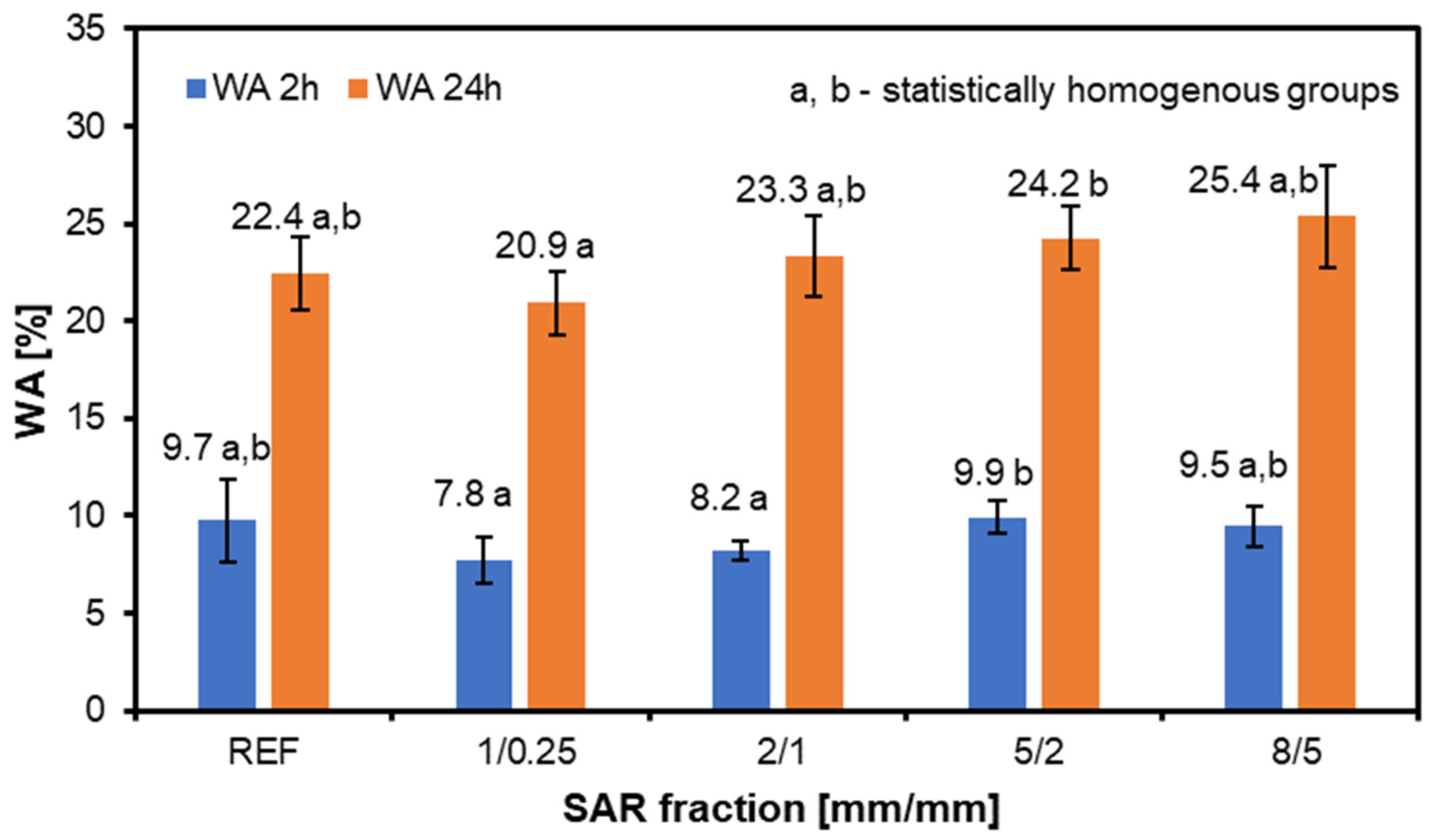

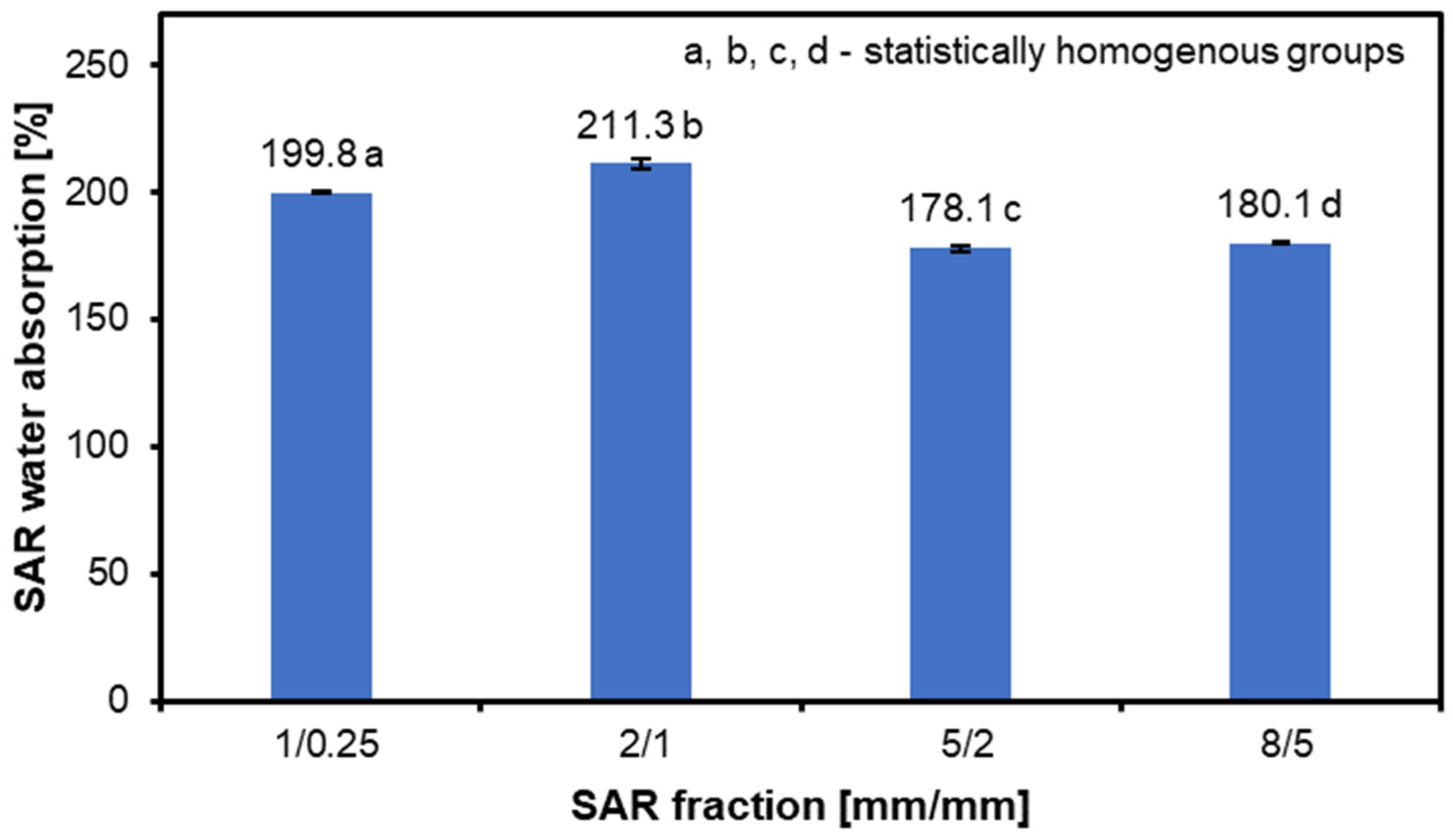
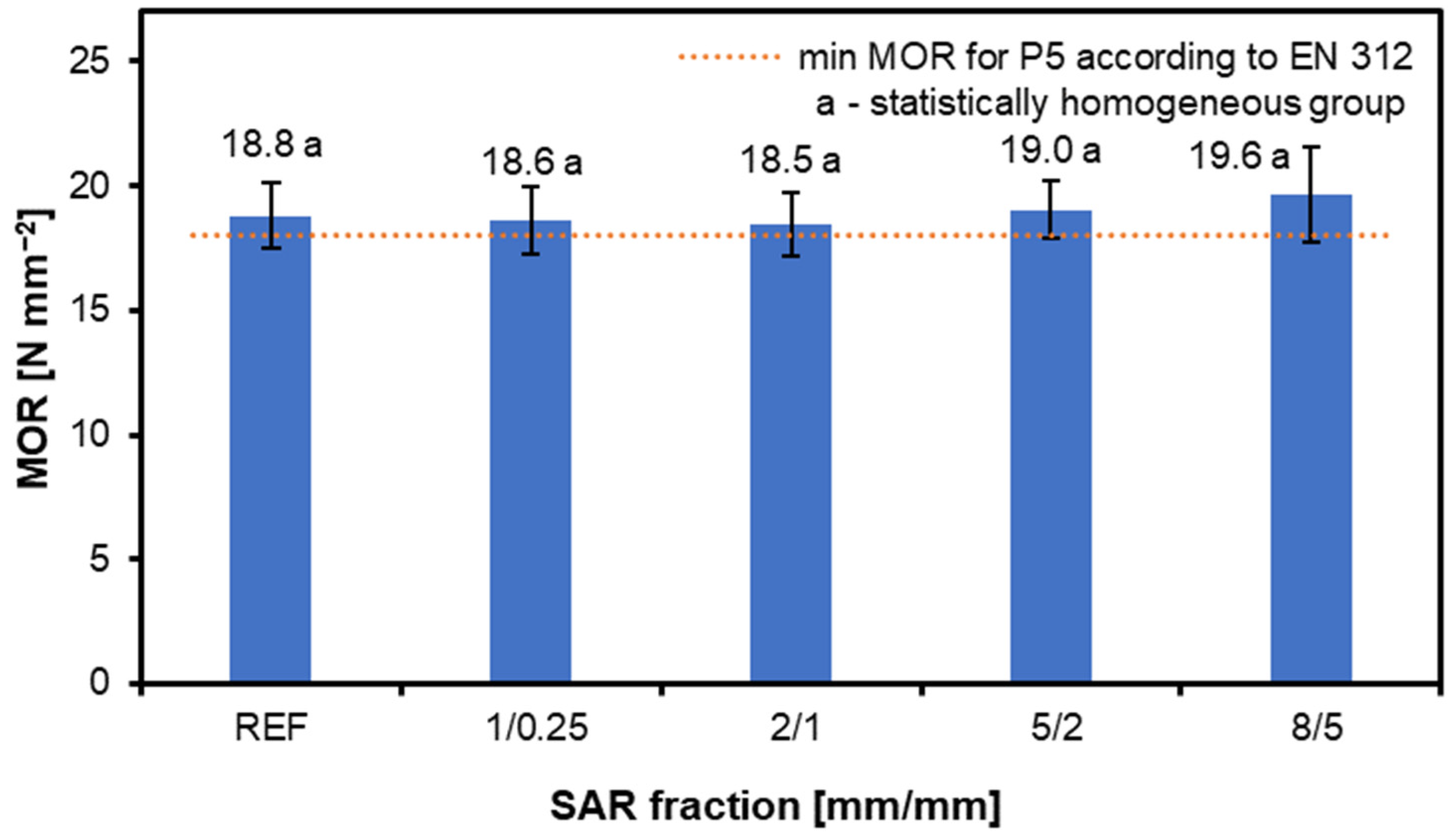

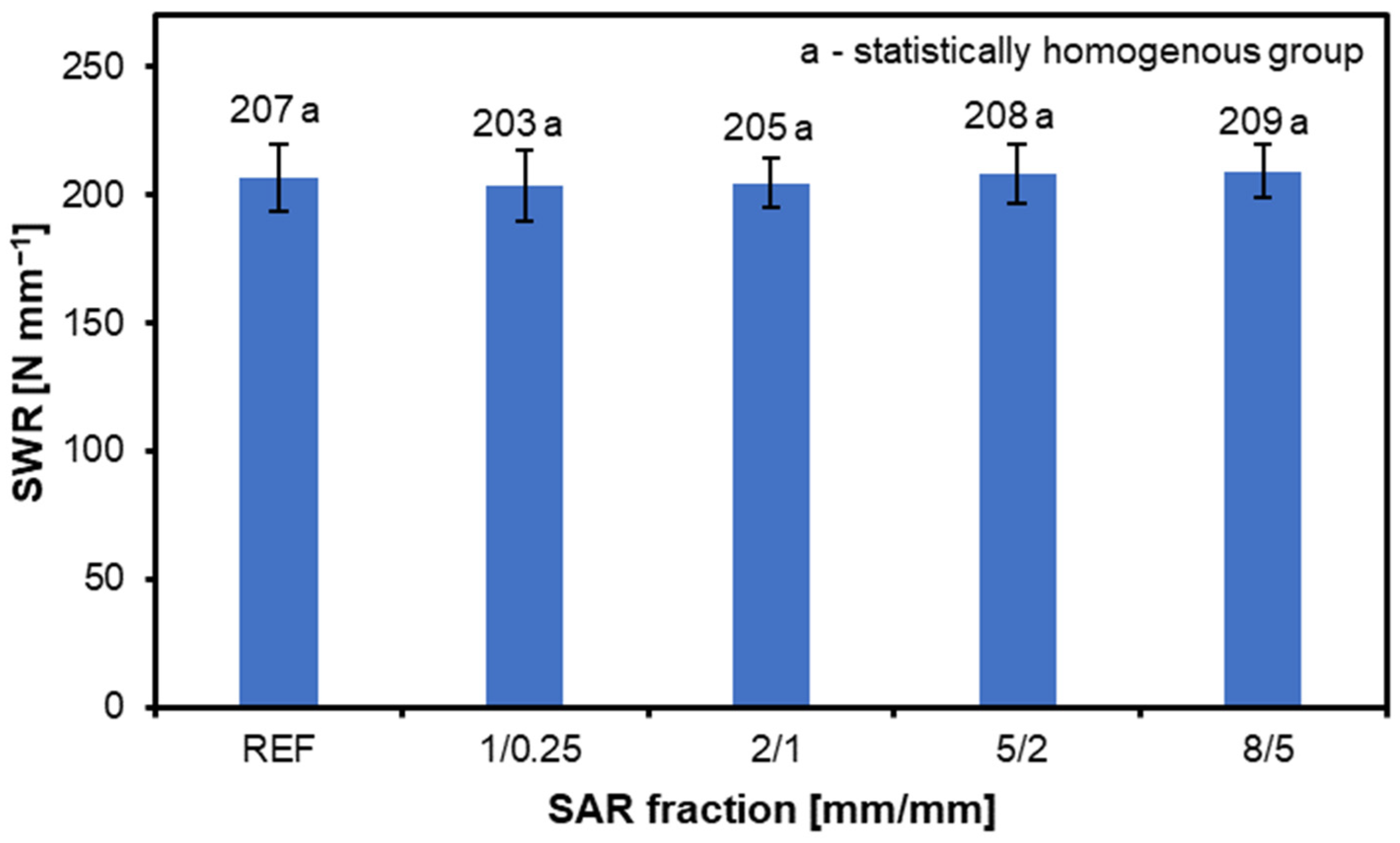
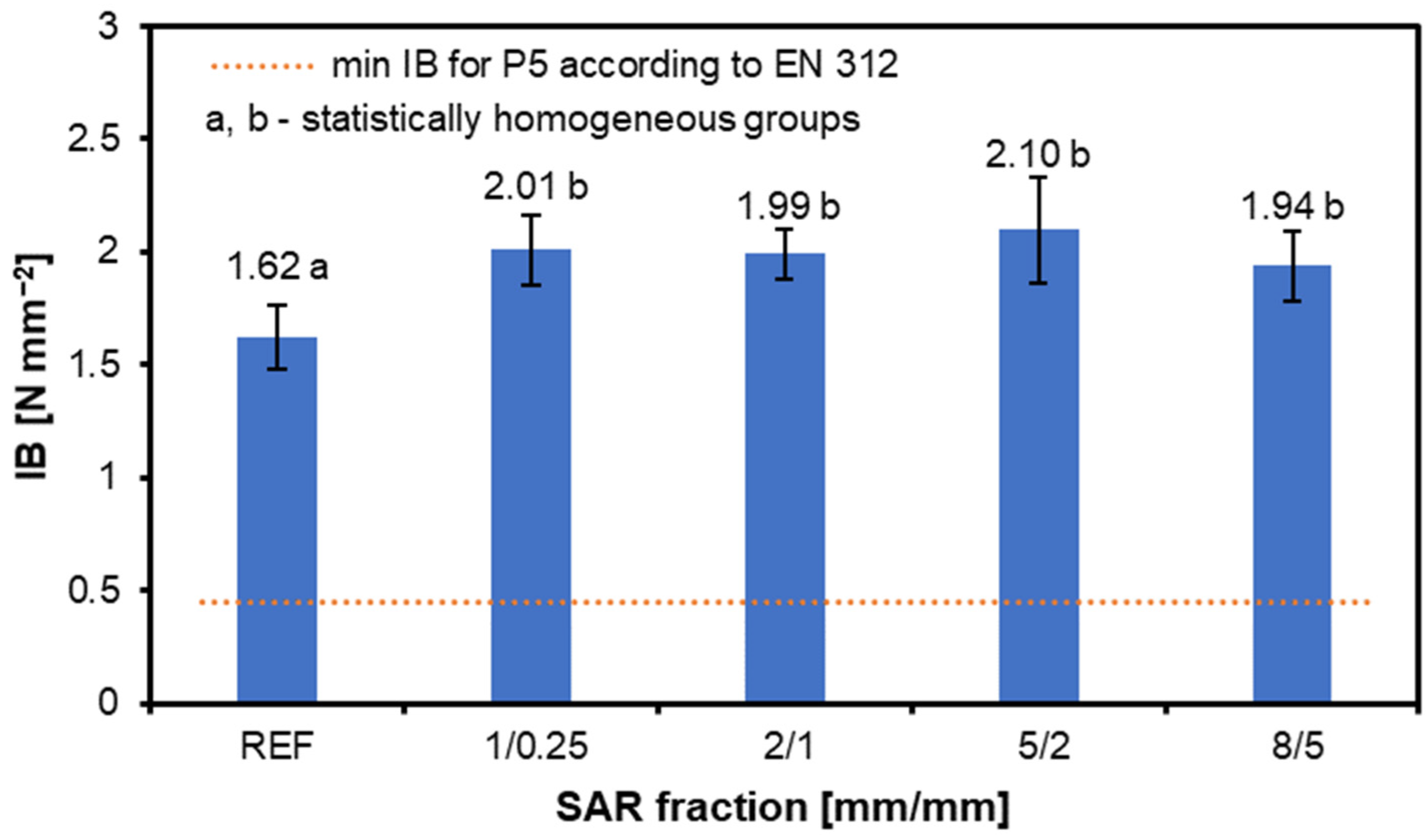


| Group | Key Findings | Source |
|---|---|---|
| Material types (OSB, particleboard, and P5) | Due to their strength, moisture resistance, and affordability, OSB and particleboard are used for construction and furniture manufacturing. P5 boards are ideal for high-humidity environments, classified under EN 312 and EN 300 standards. | [1,2,3,4,5] |
| Wood species, mechanical properties, and sustainability | Using mixed wood species, like beech–poplar and poplar–pine, enhances OSBs’ mechanical properties, such as their internal bond and bending strength. Alternative species, like birch, maple, and bamboo, can also be used, but their performance may vary. Incorporating waste materials, like sawdust, eucalyptus bark, and sugarcane bagasse, reduces the demand for virgin wood and supports environmental sustainability. Additionally, formaldehyde emissions are reduced with SAR-modified boards, contributing to a healthier indoor air quality. | [6,7,8,9,10,11,12,13,14,15,16,17,18] |
| Production factors and environmental impact | Factors, such as the resin content, strand length, and density, significantly affect OSBs’ mechanical properties. Additionally, using agricultural byproducts like straw and fruit seeds can lower production costs and the environmental impact while promoting sustainability. | [19,20,21,22] |
Disclaimer/Publisher’s Note: The statements, opinions and data contained in all publications are solely those of the individual author(s) and contributor(s) and not of MDPI and/or the editor(s). MDPI and/or the editor(s) disclaim responsibility for any injury to people or property resulting from any ideas, methods, instructions or products referred to in the content. |
© 2024 by the authors. Licensee MDPI, Basel, Switzerland. This article is an open access article distributed under the terms and conditions of the Creative Commons Attribution (CC BY) license (https://creativecommons.org/licenses/by/4.0/).
Share and Cite
Wronka, A.; Kowaluk, G. Incorporating Birch Bark Suberinic Acid Residue Powder into Structural Particleboards: Exploring Fractional Influence on Material Properties in Circular Economy Framework. Materials 2024, 17, 5750. https://doi.org/10.3390/ma17235750
Wronka A, Kowaluk G. Incorporating Birch Bark Suberinic Acid Residue Powder into Structural Particleboards: Exploring Fractional Influence on Material Properties in Circular Economy Framework. Materials. 2024; 17(23):5750. https://doi.org/10.3390/ma17235750
Chicago/Turabian StyleWronka, Anita, and Grzegorz Kowaluk. 2024. "Incorporating Birch Bark Suberinic Acid Residue Powder into Structural Particleboards: Exploring Fractional Influence on Material Properties in Circular Economy Framework" Materials 17, no. 23: 5750. https://doi.org/10.3390/ma17235750
APA StyleWronka, A., & Kowaluk, G. (2024). Incorporating Birch Bark Suberinic Acid Residue Powder into Structural Particleboards: Exploring Fractional Influence on Material Properties in Circular Economy Framework. Materials, 17(23), 5750. https://doi.org/10.3390/ma17235750








